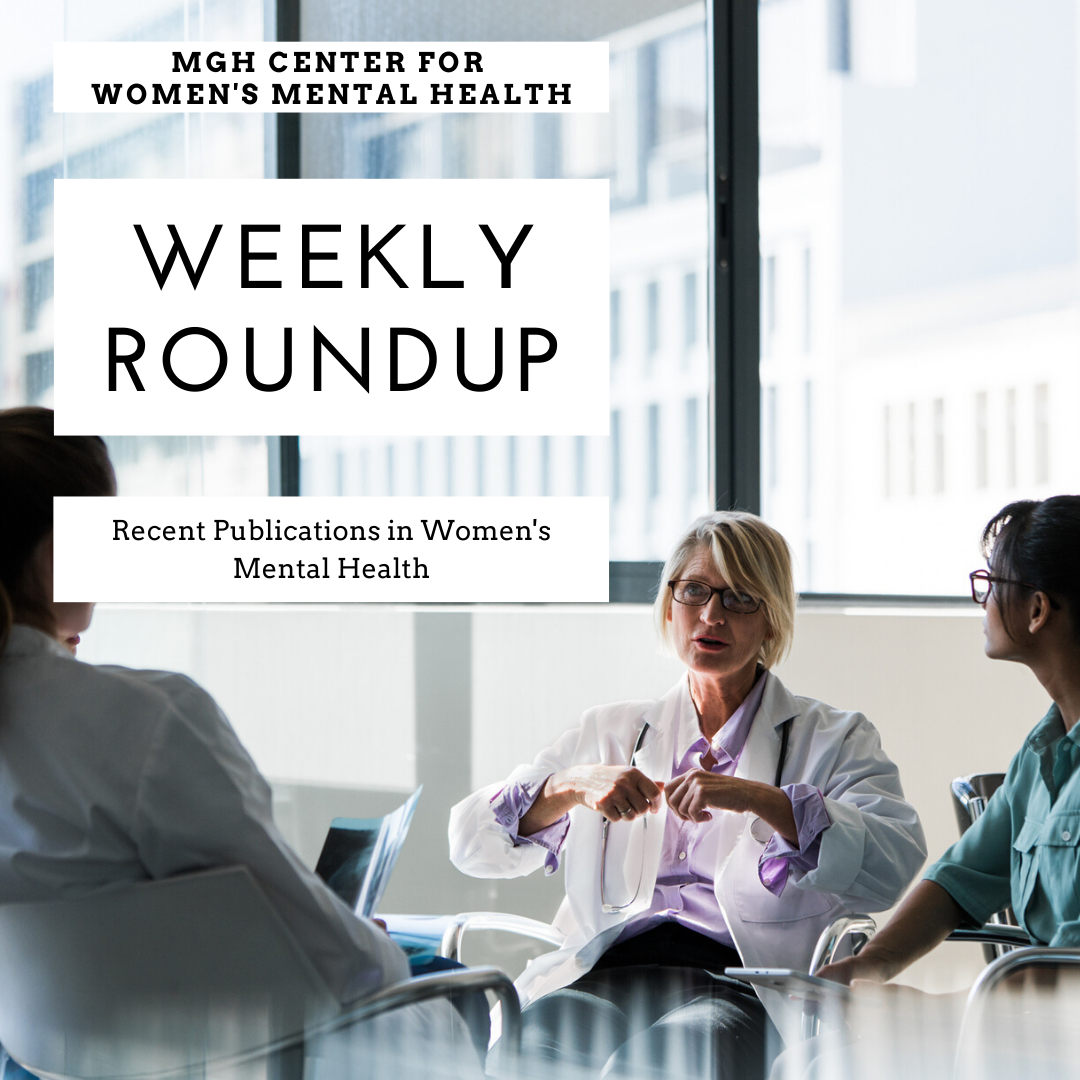
Every week we review the most recent publications in women’s mental health, covering topics related to premenstrual symptoms, perinatal mood and anxiety disorders, use of medications in pregnant and breastfeeding women, perinatal substance use, and menopausal mental health.
For more detailed descriptions of many of these topics, you can sign up to receive our weekly CWMH NEWSLETTER which comes out every Thursday.
Ruta Nonacs, MD PhD
PMS AND PMDD |
| No articles this week
|
INFERTILITY AND MENTAL HEALTH |
| No articles this week
|
PSYCHIATRIC ILLNESS DURING PREGNANCY |
| Beyond the efficacy of transcranial magnetic stimulation in peripartum depression: A systematic review exploring perinatal safety for newborns.
Miuli A, Pettorruso M, Stefanelli G, Giovannetti G, Cavallotto C, Susini O, Pasino A, Bubbico G, De Risio L, Petta GD, Sensi SL, D’Antonio F, Martinotti G. Psychiatry Res. 2023 May 22;326:115251. Eleven studies reported mothers experienced mild side effects; none of the included studies reported major side effects for newborns.
Zingg A, Singh T, Franklin A, Ross A, Selvaraj S, Refuerzo J, Myneni S. BMC Pregnancy Childbirth. 2023 Jun 3;23(1):411.
Association of serum folate levels during pregnancy and prenatal depression. Avalos LA, Nance N, Caan B, Sujan AC, Uriu-Adams JY, Li DK, Quesenberry CP, Hedderson MM. J Matern Fetal Neonatal Med. 2023 Dec;36(1):1-4. Of the sample, 13% had prenatal depression. Combined low/medium folate tertiles was associated with prenatal depression (adjusted relative risk [aRR] = 1.97, 95% confidence interval [CI]: 0.93-4.18), although results did not reach statistical significance. This relationship was stronger among women with overweight/obesity than women with normal weight (aRR: 2.61, 95% CI: 1.01-6.71 and aRR: 1.50, 95% CI: 0.34-6.66, respectively).
Magee KE, Qu Y, Cheng Y, Hipwell AE, Levine MD. Int J Eat Disord. 2023 Jun 2. High levels of lifetime depressive symptoms may increase vulnerability to future loss of control over eating (LOC) prior to first pregnancy, suggesting potential targets for interventions to improve maternal health.
Serra R, Giacchetti N, Bersani FS, Cappannini G, Martucci M, Panfili M, Sogos C, Aceti F. BMC Pregnancy Childbirth. 2023 May 25;23(1):382. Couple relation and neuroticism traits are individual factors related to depressive symptoms in the perinatal period. The family of origin also plays an indirect role on perinatal depressive symptoms.
|
MEDICATIONS AND PREGNANCY |
| Risk of Major Malformations in Infants After First-Trimester Exposure to Stimulants: Results From the Massachusetts General Hospital National Pregnancy Registry for Psychiatric Medications.
Szpunar MJ, Freeman MP, Kobylski LA, Rossa ET, Gaccione P, Chitayat D, Viguera AC, Cohen LS. J Clin Psychopharmacol. 2023 May 29. The odds ratio of a major malformation among infants after first-trimester exposure to any stimulant was 0.39 (95% confidence interval, 0.09-1.61) compared with controls.
|
POSTPARTUM PSYCHIATRIC ILLNESS |
| SmartMoms – a web application to raise awareness and provide information on postpartum depression.
Daehn D, Martens C, Loew V, Kemmler L, Rudolf S, Kochen E, Renneberg B, Pawils S. BMC Pregnancy Childbirth. 2023 May 31;23(1):402. SmartMoms is a German mobile web application (web app) designed to inform women about postpartum depression, support them, and provide an easily accessible self-screening instrument.
Smith HC, Petersen I, Schartau P. JAMA Netw Open. 2023 May 1;6(5):e2316105. This study suggests that recently having a child was not associated with an increase in antidepressant treatment among men, but previous antidepressant treatment in fathers was strongly associated with treatment after childbirth (aPRR, 32.31).
Shorey S, Downe S, Chua JYX, Byrne SO, Fobelets M, Lalor JG. Trauma Violence Abuse. 2023 Jul;24(3):1238-1253. Psychological interventions were more effective in reducing fear of childbirth and improving PTSD symptoms compared to anxiety and depression. Greater improvement in depression was reported at 3-8 weeks’ follow-up than at immediate post-intervention. Subgroup analyses showed that technology-based interventions were feasible, and indicated interventions were more effective than selective interventions. Conducting future interventions in more geographical regions, engaging and including fathers more actively, incorporating both personalized professional therapy and informal peer support, striving for flexibility and convenience, as well as addressing topics on self-doubt and coping skills can improve current interventions.
Safety of Brexanolone in Adults with Postpartum Depression: Postmarketing Surveillance Data. Garafola S, Shiferaw E, Dev V. Drugs Real World Outcomes. 2023 Jun 6. Overall, 499 patients received brexanolone in this postmarketing surveillance analysis. There were 396 total AEs: 15 serious unlisted, 2 serious listed, 346 nonserious unlisted, and 33 nonserious listed. In total, two serious and one nonserious listed excessive sedation AEs were reported-all resolved by stopping infusion and did not require any treatment; no loss of consciousness AEs were received.
The Effects of Perceived Social Support on Postpartum Anxiety: A Moderated Mediation Model. Yan P, Xu J. Matern Child Health J. 2023 Aug;27(8):1426-1433. Self-esteem partially mediated the relationship between perceived social support and postnatal anxiety, and this mediating process was moderated by optimism.
|
MEDICATIONS AND BREASTFEEDING |
| Infant exposure to Fluvoxamine through placenta and human milk: a case series – A contribution from the ConcePTION project.
Monfort A, Cardoso E, Eap CB, Fischer Fumeaux CJ, Graz MB, Morisod Harari M, Weisskopf E, Gandia P, Allegaert K, Nordeng H, Hascoët JM, Claris O, Epiney M, Csajka C, Guidi M, Ferreira E, Panchaud A. Front Psychiatry. 2023 May 18;14:1167870.
|
PERINATAL SUBSTANCE USE |
| Cannabis use, cannabis use disorder and mental health disorders among pregnant and postpartum women in the US: A nationally representative study.
Brown QL, Shmulewitz D, Sarvet AL, Young-Wolff KC, Howard T, Hasin DS. Drug Alcohol Depend. 2023 Jul 1;248:109940. The prevalence of past-year cannabis use and CUD was 9.8% and 3.2%, respectively. The odds of cannabis use (aORs range 2.10-3.87) and CUD (aORs range 2.55-10.44) were higher among women with versus without any past-year mood, anxiety or posttraumatic stress disorders or any lifetime personality disorder.
Sujan AC, Alexeeff SE, Slama N, Avalos LA, Adams SR, Conway A, Ansley D, Young-Wolff KC. J Addict Med. 2023 May-Jun 01;17(3):e141-e147. This study identified the following 4 latent groups with different patterns of substance use: ( a ) predominantly alcohol and no other substances (9.30%), ( b ) predominantly cannabis and no other substances (4.88%), ( c ) predominantly nicotine and some pharmaceutical opioids (1.09%), and ( d ) high-polysubstance (alcohol, cannabis, nicotine, and stimulants; 0.36%); ( e ) no prenatal substance use (84.37%).
A systematic review of in utero cannabis exposure and risk for structural birth defects. Sujan AC, Pal A, Avalos LA, Young-Wolff KC. Front Pediatr. 2023 May 25;11:1149401. Within the 12 articles reviewed, four reported on cardiac malformations, three reported on central nervous system malformations, one reported on eye malformations, three reported on gastrointestinal malformations, one reported on genitourinary malformations, one reported on musculoskeletal malformations, and two reported on orofacial malformations.
|
MATERNAL MENTAL HEALTH AND CHILD OUTCOMES |
| The Effects of Maternal Perinatal Depression on Child IQ: A Systematic Review.
Baird H, Harris RA, Santos HP Jr. Matern Child Health J. 2023 Jun 6. Across the studies, this review identified a relationship between limited maternal responsiveness due to postpartum depression and a decrease in full IQ scores in younger children. Male children were found to be more sensitive to the postpartum depression, resulting in a decrease in IQs, in comparison to female children.
Na X, Glasier CM, Andres A, Bellando J, Chen H, Gao W, Livingston LW, Badger TM, Ou X. Cereb Cortex. 2023 May 22:bhad176. Significant negative correlations were identified between neonatal brain functional connectivity and mother’s Beck Depression Inventory-II scores in the third trimester, but not in the first or second trimester. Higher depressive symptoms during the third trimester of pregnancy were associated with lower neonatal brain functional connectivity in the frontal lobe and between frontal/temporal lobe and occipital lobe, indicating a potential impact of maternal depressive symptoms on offspring brain development, even in the absence of clinical depression.
|
MENOPAUSE AND MENTAL HEALTH |
| No articles this week
|
OTHER TOPICS IN WOMEN’S MENTAL HEALTH |
| No articles this week
|



Leave A Comment